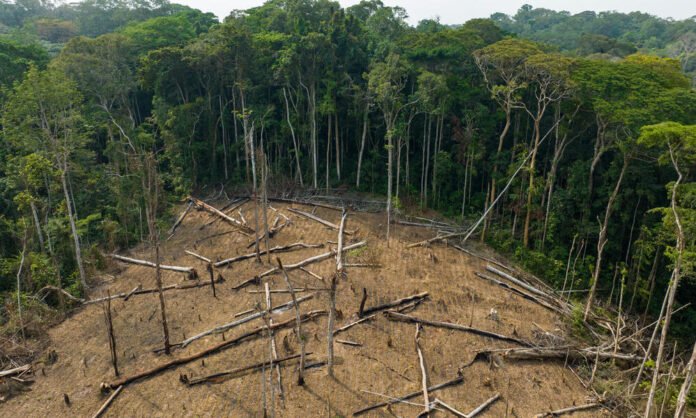Understanding Forest Crime and Its Interconnections
Forest crime refers to a range of illegal activities that threaten forests and biodiversity, predominantly characterized by actions such as illegal logging, deforestation, forest land grabbing, and the illicit trade of timber. The United Nations Office on Drugs and Crime (UNODC) identifies forest crime as a significant component of organized crime, where offenders exploit natural resources for economic gain, often bypassing legal regulations and ignoring environmental consequences. This illegal exploitation not only diminishes forest health but also has far-reaching implications for global biodiversity and climate change.
In understanding the complexities of forest crime, it becomes clear that these illegal acts frequently intersect with other forms of organized crime. For example, illegal mining often occurs in forested areas, leading to deforestation and habitat destruction. Similarly, the illegal drug trade often exploits remote forest regions for cultivation, impacting local ecosystems and communities. The trafficking of humans can also be linked to forest crime, as migrant workers may be illegally employed in logging operations or land clearing, putting them at risk of exploitation and abuse.
The web of illicit activities surrounding forest crime reveals a stark reality: these offenses are not isolated incidents but part of a broader pattern of organized crime. By recognizing and analyzing the connections between forest crime and other criminal enterprises, stakeholders can better understand how such interrelations exacerbate environmental degradation and undermine social stability. The importance of adopting a multi-faceted approach that encompasses law enforcement, environmental protection, and community engagement is paramount in addressing these challenges. A coordinated response can foster an environment where legal activities can thrive, thereby reducing the appeal of engaging in forest crime.
The Impact on the Environment and Communities
The convergence of forest crime with organized crime poses significant threats to both the environment and local communities. Illegal logging and deforestation lead to severe environmental degradation, contributing to biodiversity loss and climate change. As forests are cut down illegally to meet the demands of various illicit markets, critical habitats for countless animal and plant species are destroyed. This loss of biodiversity not only disrupts ecosystems but also diminishes the resilience of these environments in the face of climate change.
Moreover, the deforestation resulting from such criminal activities exacerbates greenhouse gas emissions, further intensifying global warming. The trees that once absorbed CO2 are removed, leading to increased carbon levels in the atmosphere. This process not only affects local climates but also has far-reaching effects on global weather patterns, impacting agricultural productivity and food security worldwide. The cyclical nature of climate change and forest degradation underscores the gravity of forest crime’s environmental ramifications.
Local communities bear the brunt of these adverse effects as their livelihoods are closely tied to the health of forests. Many rural populations rely on forest resources for their sustenance, cultural identity, and economic activities. When forested areas are ravaged by illegal logging, these communities are deprived of vital resources such as timber, fruits, and medicinal plants, pushing them into a cycle of poverty and vulnerability. Furthermore, the influx of organized crime can lead to social unrest, as community members may find themselves at odds with criminal enterprises that prioritize profit over ecological and social well-being.
The implications of these environmental harms extend beyond local contexts, affecting global stability. As forest crime continues to escalate, the interconnected issues of climate change, biodiversity loss, and societal disruption call for coordinated action. Addressing the roots of forest crime and mobilizing efforts to protect both the environment and affected communities are essential steps towards achieving a sustainable and stable future.
Key Actors and Market Dynamics in Forest Crime
Forest crime is often characterized by a complex interaction between various actors, including organized crime groups, corrupt officials, and legitimate businesses driven by profit motives. These entities leverage the lucrative nature of illegal logging and timber trafficking, thereby creating a thriving underground economy that undermines sustainability efforts and legal frameworks. Organized crime groups, in particular, have increasingly recognized the profitability of forest crime, utilizing their established networks to facilitate illegal activities ranging from logging in protected areas to trafficking in endangered species.
One of the key mechanisms through which these actors operate is the acquisition of fraudulent permits. By manipulating regulatory systems and exploiting legal loopholes, they are able to present illegally sourced timber as legally harvested products. This not only allows them to profit from illicit activities but also poses significant challenges to forest governance and law enforcement. Corruption plays a pivotal role in this process; officials can be bribed to issue permits or turn a blind eye to illegal operations, effectively legitimizing activities that contribute to deforestation, loss of biodiversity, and environmental degradation.
Market dynamics also play a critical role in fostering an environment conducive to forest crime. The demand for cheap and accessible timber drives illegal logging practices, allowing organized crime syndicates to thrive. In addition, the increasing sophistication of logistics and transportation networks used by these actors enables the quick movement of illegally harvested timber across borders, further complicating enforcement efforts. Furthermore, as legitimate businesses may inadvertently engage with tainted supply chains, the lines between legal and illegal practices can become blurred, leading to a more pervasive acceptance of forest crime in various markets.
Policy Implications and the Path Forward
The intersection of forest crime and organized crime presents a significant challenge for environmental conservation, economic stability, and social justice. Existing policies aimed at combating forest crime have had varying degrees of effectiveness. While some regulatory frameworks have successfully curtailed certain aspects of illegal logging and trafficking, they often struggle to address the multifaceted nature of organized criminal activities. Challenges such as inadequate enforcement resources, fragmented jurisdictional authorities, and complex legal loopholes have hindered comprehensive responses to forest-related crimes.
One of the primary successes of current policies is the heightened awareness and mobilization of international bodies in forest crime prevention. Treaties and agreements, such as the Forest Law Enforcement, Governance and Trade (FLEGT) initiative, have provided guidelines for countries to enhance governance and accountability related to forest management. However, unintended consequences have arisen from strict regulations, such as pushing illegal activities further underground, thereby complicating enforcement efforts. For instance, stringent measures may incentivize more sophisticated methods of concealment by organized crime groups, further entrenching their operations.
To address these complexities, there is an urgent need for adaptable policy frameworks that can efficiently respond to evolving illegal strategies. Such frameworks should prioritize not only enforcement but also community engagement and sustainable livelihood programs that alleviate the socio-economic pressures driving individuals toward participation in forest crime. Furthermore, enhanced collaboration across nations will be essential in creating a unified approach to combat these interlinked issues. International partnerships can facilitate knowledge sharing and resource mobilization, ultimately contributing to a more resilient legal and regulatory environment. By bolstering enforcement mechanisms and closing existing loopholes, governments can significantly diminish the nexus between forest crime and organized crime, leading to improved outcomes for both communities and ecosystems alike.


Want to try trading without any risk? Open a demo account on Pocket Option and get virtual funds to practice right now. Test your strategies, explore the market, and gain real experience with zero investment. Try the demo for free https://www.youtube.com/watch?v=VmHYisHHOtU
to UNSUBSCRIBE:
https://casatemporada.site/unsubscribe?domain=menaeditorsnetwork.org
Address: 209 West Street Comstock Park, MI 49321
World’s FIRST AI System That Creates PROFITABLE Amazon Books In Under 6 Minutes Across 25+ Niches
https://goldsolutions.pro/RoyaltyProfitsAI
to UNSUBSCRIBE:
https://goldsolutions.pro/unsubscribe?domain=menaeditorsnetwork.org
Address: 209 West Street Comstock Park, MI 49321
With Just 3 Clicks, You Will Be Able To Unlock All TOP AI Models with All Versions + All Upcoming Future Versions… Without Spending A Penny …
https://bravo-333.site/MultiverseAI
to UNSUBSCRIBE:
https://bravo-333.site/unsubscribe?domain=menaeditorsnetwork.org
Address: 209 West Street Comstock Park, MI 49321
How Everyday People Are Turning
Free AI Videos Into $500+ Days…
While Chillin’ On Their Phone / Computer?
https://smartexperts.pro/Vyralzz
to UNSUBSCRIBE:
https://smartexperts.pro/unsubscribe?domain=menaeditorsnetwork.org
Address: 209 West Street Comstock Park, MI 49321
Very interesting points you have noted, thankyou for putting up.